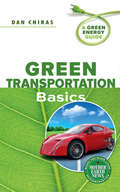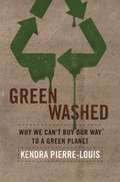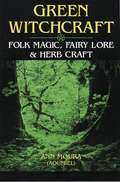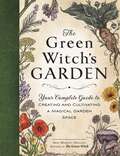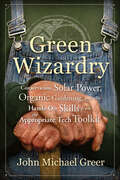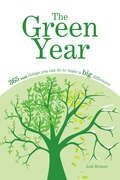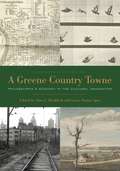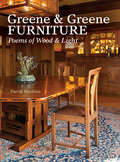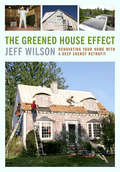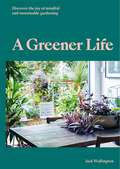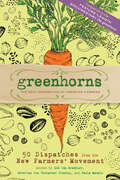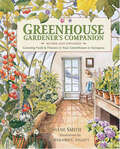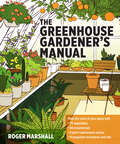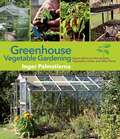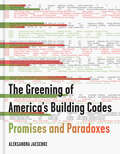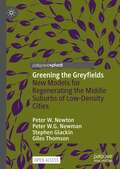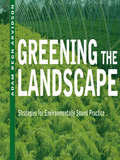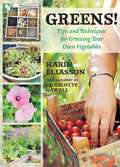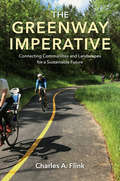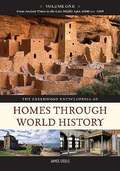- Table View
- List View
Green Transportation Basics
by Dan ChirasOur automobile culture is devastating for the environment, but private passenger vehicles are unlikely to disappear from our roads anytime soon. Greener cars and fuels will be a necessity for many years to come.Green Transportation Basics is a guide to greening your personal driving habits by dramatically improving the efficiency of an existing vehicle using simple measures such as trip planning and regular maintenance to improve fuel economy. This handy guide also explores the most promising new green cars and trucks, including electric vehicles, hybrids, plug-in hybrids, and natural-gas cars. And it critically examines sustainable fuels including ethanol, biodiesel, straight vegetable oil, hydrogen, and biomethane, evaluating each according to a set of established criteria. Each green fuel source must:Be socially, economically, and environmentally sustainableHave a high net energy yieldBe clean, abundant, renewable, and affordableDon't let your dream of greening your transportation idle-Green Transportation Basics will guide you through the myths and misconceptions and provide clear options for the road to a more sustainable future.Dan Chiras is a respected educator and author who has published nearly thirty books on renewable energy and sustainable living, including Power from the Sun and Power from the Wind. He is the director of the Evergreen Institute, where he teaches workshops on green transportation, including green fuels and vehicles and electric car conversion.
Green Washed
by Kendra Pierre-LouisThe message that our environment is in peril has filtered from environmental groups to theAmerican consciousness to our shopping carts. Every day, millions of Americans dutifully replace conventional produce with organic, swap Mr. Clean for Seventh Generation, and replace their bottled water with water bottles. Many of us have come to believe that the path to environmental sustainability is paved by shopping green. Although this green consumer movement certainly has many Americans consuming differently, it raises an important and rarely asked question--"is this consumption really any better for the planet?" By examining the major economic sectors of our society, including infrastructure (green housing), consumer goods (green clothing and jewelry), food (the rise of organic), and energy (including solar power and the popularity of the hybrid car), Green Washed: Why We Can't Buy Our Way to a Green Planet explains that, though greener alternatives are important, we cannot simply buy our way to sustainability. Rather, if it is the volume of our consumption that matters, can we as a society dependent on constantly consuming ever be content with buying less? A new and unique take on green consumption, Green Washed shows how buying better is only the first step toward true sustainability. Kendra Pierre-Louis is the sustainable development editor for Justmeans.com. She holds a master's degree in sustainable development from the SIT Graduate Institute in Vermont. She has created outreach material for the United Nations Environment Programme's Convention on Biological Diversity and worked as a researcher for Terrapin Bright Green, an environmental consulting and strategic planning firm.
Green Witchcraft: Folk Magic, Fairy Lore, & Herb Craft
by Ann MouraLearn the basics of Witchcraft from a third-generation Witch raised in a family tradition. Positive, practical, and easy to use, Green Witchcraft brings together the best of both modern Wicca and the author's family heritage of herb craft and folk magic. Green Witchcraft explores the fundamentals of the Wiccan religion, providing magical training for the independent thinker. Step-by-step instructions on a wide variety of magical techniques as well as basic rules of conduct make this the ideal book to get you started. Green rituals for self-initiation, rites of passage, seasonal celebrations and activities provide an excellent foundation for your own magical tradition. Discover the fine art of spell-casting, the magical uses of herbs, divination with the tarot and more. Explore the Sabbats, Esbats, and other rituals attuned to the cycles of nature and the universal powers. Find out for yourself what this organic approach to Witchcraft is all about.
The Green Witch's Garden: Your Complete Guide to Creating and Cultivating a Magical Garden Space
by Arin Murphy-HiscockCreate your own enchanting witch&’s garden and draw energy from the earth with this guide to cultivating your very own magical ingredients.A green witch embraces the power of nature, draws energy from the earth and the universe, and relies on stones, plants, flowers, and herbs for healing. In The Green Witch&’s Garden, you will learn how to create your own magical space to enhance your witchcraft practice. With information on how to plan and design your sacred garden and tips and tricks to growing and harvesting magical ingredients, this book will allow you to take control of your practice and more deeply connect with the earth. Let experienced witch and author of The Green Witch Arin Hiscock-Murphy guide you on your path to creating your personal piece of nature.
Green Wizardry: Conservation, Solar Power, Organic Gardening, and Other Hands-On Skills from the Appropriate Tech Toolkit
by John Michael GreerGreen Wizardry is a hands-on guide to homescale energy conservation, backyard food production and other commonsense responses to scarcity. Written by a veteran of the 1970s appropriate technology movement, it offers tried and tested solutions and a wealth of nearly forgotten practical skills to help individuals, families and communities cope creatively with the end of the age of cheap energy.
The Green Year: 365 Small Things You Can Do to Make a Big Difference
by Jodi HelmerGo green one day at a time. Do something every day. Most of us want to do the right thing for the environment, but making the commitment to change our fast-paced, convenience-oriented lifestyles can be more than a little daunting. What&’s the answer? Take that giant commitment and cut it up into 365 little commitments that get met one day at a time. The Green Year does just that. More than a calendar, it offers simple, practical, affordable, and engaging activities that make going green a blessing rather than a burden. In addition to these easy green suggestions, readers will find in The Green Year: • The &“why&” behind each activity—what makes it good for the environment and the reader? • A quick &“how-to&” for any activity that requires it • Room for readers to write in their own creative alternatives • Helpful illustrations
A Greene Country Towne: Philadelphia’s Ecology in the Cultural Imagination
by Alan C. Braddock Laura Turner IgoeAn unconventional history of Philadelphia that operates at the threshold of cultural and environmental studies, A Greene Country Towne expands the meaning of community beyond people to encompass nonhuman beings, things, and forces.By examining a diverse range of cultural acts and material objects created in Philadelphia—from Native American artifacts, early stoves, and literary works to public parks, photographs, and paintings—through the lens of new materialism, the essays in A Greene Country Towne ask us to consider an urban environmental history in which humans are not the only protagonists. This collection reimagines the city as a system of constantly evolving constituents and agencies that have interacted over time, a system powerfully captured by Philadelphia artists, writers, architects, and planners since the seventeenth century. In addition to the editors, contributors to this volume are Maria Farland, Nate Gabriel, Andrea L. M. Hansen, Scott Hicks, Michael Dean Mackintosh, Amy E. Menzer, Stephen Nepa, John Ott, Sue Ann Prince, and Mary I. Unger.
A Greene Country Towne: Philadelphia’s Ecology in the Cultural Imagination
by Alan C. Braddock Laura Turner IgoeAn unconventional history of Philadelphia that operates at the threshold of cultural and environmental studies, A Greene Country Towne expands the meaning of community beyond people to encompass nonhuman beings, things, and forces.By examining a diverse range of cultural acts and material objects created in Philadelphia—from Native American artifacts, early stoves, and literary works to public parks, photographs, and paintings—through the lens of new materialism, the essays in A Greene Country Towne ask us to consider an urban environmental history in which humans are not the only protagonists. This collection reimagines the city as a system of constantly evolving constituents and agencies that have interacted over time, a system powerfully captured by Philadelphia artists, writers, architects, and planners since the seventeenth century. In addition to the editors, contributors to this volume are Maria Farland, Nate Gabriel, Andrea L. M. Hansen, Scott Hicks, Michael Dean Mackintosh, Amy E. Menzer, Stephen Nepa, John Ott, Sue Ann Prince, and Mary I. Unger.
Greene & Greene Furniture: Poems of Wood & Light
by David MathiasOne hundred years ago Charles and Henry Greene developed a new and distinctive architectural and decorative style that blended Arts & Crafts and Asian influences with California sensibility and obsessive attention to detail. That innovative style is instantly recognizable today. "David Mathias, author of this richly personal appreciation of the Greenes...comes to Greene and Greene from the perspective of an amateur woodworker with a fine aesthetic sense. Through his writing we are able to appreciate the Greenes' houses and furnishings almost as if we were hearing from one of their builders. Through stunning and perceptive new photography, the illustrated spaces and furnishings illuminate the genius of the Greenes' designs, material selection and craft, which has caused so many to celebrate and be seduced by their work...Being a woodworker, Mathias also pays due homage to John and Peter Hall, the Swedish brothers who worked closely with the Greenes on their finest houses. Mathias correctly grasps how without the Halls, the Greenes would lack a significant measure of the reputation that they enjoy today. Relatively few writers have focused exclusively on Greene and Greene, and so it is a privilege whenever a talented one such as Mr. Mathias comes along. Be forewarned that through this book his seduction may become yours, too." Edward R. Bosley, James N. Gamble Director The Gamble House, Pasadena School of Architecture, University of Southern
The Greened House Effect
by Jeff WilsonWith greater public awareness of the need for energy independence, the issue of how we can make our existing homes more resource efficient is becoming ever more critical. Residential buildings make up a large fraction of our energy needs, largely due to heating and air-conditioning. So it's no longer enough to simply do the small stuff, like switching to compact fluorescent bulbs, or turning down the thermostat at night. In The Greened-House Effect, author Jeff Wilson brings his twenty-five years of construction experience and knowledge of home building to bear on making our current houses cleaner, greener, and healthier. Think of a deep-energy retrofit (DER) as a "home makeover" - one that represents a significant investment, but that saves money from the get-go by capturing the energy you "drop on the ground" every month, every year, through inefficiency, poor design, or simply living in a typical older home. Using his own family's DER of their 1942 home as a prime example, Wilson weaves a readable narrative at a practical, hammer-and-nail level. He presents the solutions to our building and energy problems, making them seem possible for average homeowners and small contractors by offering the right set of information, skills, and materials. More technical information is presented in sidebars and graphs, and numerous color photos illustrate the process, including: Testing the energy efficiency of your home and learning where improvements need to be made Issues of local building codes and regulations Financing and paying for a DER Major components of the DER, such as roofs, exterior walls, basements, and home systems Wilson's building experience, along with his lifelong passion for energy issues, all come together to form an inspirational, can-do approach to making our neighborhood, our community, our nation, and our world a better place - one home at a time.
A Greener Life: Discover the joy of mindful and sustainable gardening
by Jack Wallington'This is a clearly presented work, with accessible topic headings and plenty of good advice sprinkled with engaging personal anecdotes. The message at the book's heart is to adopt a greener way of being and to see oneself as part of nature, not removed from it. On this point it is exceptional, distinguishing itself from many of the green gardening books written in recent years.' The English Garden magazine'Conversational, interesting, and personal ... it reaffirms the link between what we love to do and why we should be doing it with nature, the planet and our health in mind.' RHS The Garden magazineIf you want a sustainable garden and a better relationship with nature, A Greener Life is the guide you need. Packed with inspirational images and practical tips, the book covers garden planning, organic composting and vegetable growing, as well as sustainable planting, rewilding and wildlife-attracting environments. Learn traditional gardening techniques like propagating and growing from cuttings to make your garden self-sustaining, and discover plants that attract hover flies, bees and butterflies. With Jack Wallington's warmth and expertise on every page, this is an ideal book for new gardeners seeking greener practices.
A Greener Life: Discover the joy of mindful and sustainable gardening
by Jack Wallington'This is a clearly presented work, with accessible topic headings and plenty of good advice sprinkled with engaging personal anecdotes. The message at the book's heart is to adopt a greener way of being and to see oneself as part of nature, not removed from it. On this point it is exceptional, distinguishing itself from many of the green gardening books written in recent years.' The English Garden magazine'Conversational, interesting, and personal ... it reaffirms the link between what we love to do and why we should be doing it with nature, the planet and our health in mind.' RHS The Garden magazineIf you want a sustainable garden and a better relationship with nature, A Greener Life is the guide you need. Packed with inspirational images and practical tips, the book covers garden planning, organic composting and vegetable growing, as well as sustainable planting, rewilding and wildlife-attracting environments. Learn traditional gardening techniques like propagating and growing from cuttings to make your garden self-sustaining, and discover plants that attract hover flies, bees and butterflies. With Jack Wallington's warmth and expertise on every page, this is an ideal book for new gardeners seeking greener practices.
Greenhorns: 50 Dispatches from the New Farmers' Movement
by Zoe Ida Bradbury Severine Von Fleming Paula ManaloThe Greenhorns are a community of more than 5,000 young farmers and activists committed to producing and advocating for food grown with vision and respect for the earth. <P><P>This book, edited by three of the group’s leading members, comprises 50 original essays by new farmers who write about their experiences in the field from a wide range of angles, both practical and inspirational. <P><P>Funny and sad, serious and light-hearted, these essays touch on everything from financing and machinery to family, community building, and social change.
Greenhouse Gardener's Companion, Revised and Expanded Edition: Growing Food & Flowers in Your Greenhouse or Sunspace
by Shane Smith Majorie LeggittThe most comprehensive book on greenhouse gardening available today. Today, greenhouses and sunrooms are real living spaces where gardeners spend as much time with a book and a cup of coffee as they do with a watering can and a pair of pruning shears. In this fully revised edition of a best-selling classic, veteran gardener Shane Smith embraces this new "lifestyle" approach to greenhouse gardening. Through lively writing that balances wit with commonsense advice, Smith draws on his more than 20 years' experience to cover everything you need to know to establish a charming and productive greenhouse.
The Greenhouse Gardener's Manual
by Roger MarshallImagine biting into a fresh, juicy tomato straight from the vine in the middle of winter or growing a collection of succulents and cacti the coldest parts of the world. In The Greenhouse Gardener's Manual, Roger Marshall providesevery tool and technique you need to successfully grow edibles and ornamentals in a well-maintained greenhouse. Marshall offers insight to choose the right greenhouse, create a healthy environment, start seeds and propagate, and maintain your greenhouse.
Greenhouse Gardening
by Sunset Publishing StaffGreenhouse Gardening takes the reader through the intricacies of uding modern greenhouses to grow plants. Building a greenhouse, choosing plants, and special features of greenhouses are covered.
Greenhouse Production
by Ronald J. BiondoGreenhouse Production is a comprehensive book based on the green¬house industry. It takes the reader beyond the most basic levels of horticulture. It includes botany and the production of floriculture crops.
Greenhouse Vegetable Gardening: Expert Advice on How to Grow Vegetables, Herbs, and Other Plants
by Inger Palmstierna"A garden should be easy and fun to care for-don't complicate things unnecessarily." This is the slogan of author Inger Palmstierna. In Greenhouse Vegetable Gardening, she helps readers find the joy of cultivating in their very own greenhouses. Palmstierna is a gardening authority with vast knowledge on everything that grows. With infectious enthusiasm, this garden writer and horticulturist explains how to cultivate a successful garden or orchard.The greenhouse is the place where green thumbs are realized and your imagination can run wild. Palmstierna believes: "The greenhouse provides opportunities, but does not demand." Greenhouse Vegetable Gardening is an accessible book with many beautiful pictures and practical instructions. The topics covered include: Building and decorating your own greenhouse Training seedlings and early plant development How to sow, grow, and winter plants How to harvest vegetables and herbs How to cultivate summer flowers for planting And more!In addition to providing a garden year-round, the greenhouse can also be a beautiful addition to your yard and can be customized to match your tastes. You'll learn the basics on what to consider when buying, laying the foundations for, and decorating your greenhouse-as well as how to plan and use one. Soon after you'll be ready to explore the many types of vegetables and flowering plants that thrive in greenhouses.So get ready to enjoy fresh vegetables and flowers year-round!
The Greening of America's Building Codes: Promises and Paradoxes
by Aleksandra JaeschkeEnvironmental disasters and severe weather due to climate change, both triggered by human actions, have had an increasingly direct impact on our homes. But the way in which America builds its homes is part of the problem. This deeply researched history of sustainable design standards in building codes explores how public policy, standard-setting trade associations, and financial incentives influence the ways in which the construction of our homes impacts the environment.The Greening of America's Building Codes investigates the regulations and economic incentives meant to control the environmental impact of contemporary construction practices as it analyzes the history of residential building codes. The book exposes how the socioeconomic and political forces that influenced early building code development continue to define the character of current building codes and, by extension, determine how we regulate environmental impact and define sustainability today.More relevant than ever, The Greening of America's Building Codes is a valuable tool for architects, architecture students, builders, real estate developers, and homeowners who want to understand how public policy and their own day-to-day decisions impact the environment.
Greening the Greyfields: New Models for Regenerating the Middle Suburbs of Low-Density Cities
by Peter W. Newton Peter W.G. Newman Stephen Glackin Giles ThomsonThis open access book outlines new concepts, development models, governance and implementation processes capable of addressing the challenges of transformative urban regeneration of cities at precinct scale.
Greening the Landscape: Strategies for Environmentally Sound Practice
by Adam Regn ArvidsonA guide to improving the environmental performance of any landscape through the use of green construction and maintenance. Landscapes create obvious environmental benefits but can have unrecognized negative impacts. Adam Regn Arvidson outlines the five primary problem issues--plant pots, vehicle fuel, energy consumption, water/fertilizer use, and green waste--and details a variety of practices, ranging from exceedingly simple ideas to long-term investments, for making the installation and upkeep of landscapes more green. A companion website, GreeningtheLandscapeBook.com, provides readers with additional resources and case studies, arranged by environmental impact and geography.
Greens!: Tips and Techniques for Growing Your Own Vegetables
by Karin Eliasson Charlotte GawellGardening is on the rise as the desire for fresh, delicious homegrown vegetables grows. Growing your own vegetables is an easy hobby for a variety of lifestyles, as it doesn’t take a large amount of space to yield nutritious carrots or lettuce. All it takes is a bit of passion, care, and knowledge, and the rewards are soon there to enjoy.Both down-to-earth and inspirational, Swedish gardener Karin Eliasson describes the charm of growing your own vegetables. Karin runs a kitchen garden and guesthouse in Spain, but her tips are adapted to suit most climates and soil types. In this gardening guide, she gives advice on how to grow, harvest, and store over 100 different vegetable varieties and suggests easy recipes you can use in your own kitchen. With instructive and beautiful photographs, she explains the step-by-step principles of organic gardening—soil, plant feeding, digging, hoeing, and watering—and shows how to combine blooming flowers and vegetables in attractive, colorful mixes to attract garden-friendly insects.This book will not only arm you with the knowledge you need to get started, but also provide experienced and budding gardeners alike with a source for inspiration while they enjoy the beautiful photographs and tips on garden design.
The Greenway Imperative: Connecting Communities and Landscapes for a Sustainable Future
by Charles A. FlinkTrailblazing greenway projects from vision to reality In this eye-opening journey through some of America’s most innovative landscape architecture projects, Charles Flink shows why we urgently need greenways. A leading authority in greenway planning, design, and development, Flink presents inspiring examples of communities that have come together to build permanent spaces for the life-sustaining power of nature. The Greenway Imperative reveals the stories behind a variety of multiuse natural corridors, taking readers to Grand Canyon National Park, suburban North Carolina, the banks of the Miami River, and many other settings. Flink, who was closely involved with each of the projects in this book during his 35-year career, introduces the people who jumpstarted these initiatives and the challenges they overcame in achieving them. Flink explains why open green spaces are increasingly critical today. “Much more than a path through the woods,” he says, greenways conserve irreplaceable real estate for the environment, serve as essential green infrastructure, shape the way people travel within their communities, reduce impact from flooding and other natural disasters, and boost the economies of cities and towns. Greenways can and should dramatically reshape the landscape of America in the coming years, Flink argues. He provides valuable reflections and guidance on how we can create resilient communities and satisfy the human need for connection with the natural world.
The Greenwood Encyclopedia of Homes Through World History, Volume 1: From Ancient Times to the Late Middle Ages, 6000 BCE–1200
by James SteeleSteele (author and educator, U. of Southern California) provides a comprehensive survey of the housing of significant cultures from throughout the world: the Americas, Africa, Asia and Australasia, East and Southeast Asia, and Europe and the Western Mediterranean. The three-volume set spans the development of housing from ancient times to the present. While the author discusses materials used and methods of construction, he also delves into how the housing of different societies reflects their belief systems, social orders, and cultures. From the relatively familiar stone structures of Macchu Picchu to the Chinese residential districts known as hutongs, the array of architectural styles and the considerations incorporated into their construction--such as environment, light, protection, and available materials--provide a fascinating journey through history. Organized in an encyclopedic format, the set is clearly written, informative, and well-illustrated. Annotation ©2009 Book News, Inc., Portland, OR (booknews.com)
The Greenwood Encyclopedia of Homes Through World History, Volume 2: The Renaissance to the Industrial Revolution, 1201–1750
by James SteeleSteele (author and educator, U. of Southern California) provides a comprehensive survey of the housing of significant cultures from throughout the world: the Americas, Africa, Asia and Australasia, East and Southeast Asia, and Europe and the Western Mediterranean. The three-volume set spans the development of housing from ancient times to the present. While the author discusses materials used and methods of construction, he also delves into how the housing of different societies reflects their belief systems, social orders, and cultures. From the relatively familiar stone structures of Macchu Picchu to the Chinese residential districts known as hutongs, the array of architectural styles and the considerations incorporated into their construction--such as environment, light, protection, and available materials--provide a fascinating journey through history. Organized in an encyclopedic format, the set is clearly written, informative, and well-illustrated. Annotation ©2009 Book News, Inc., Portland, OR (booknews.com)
